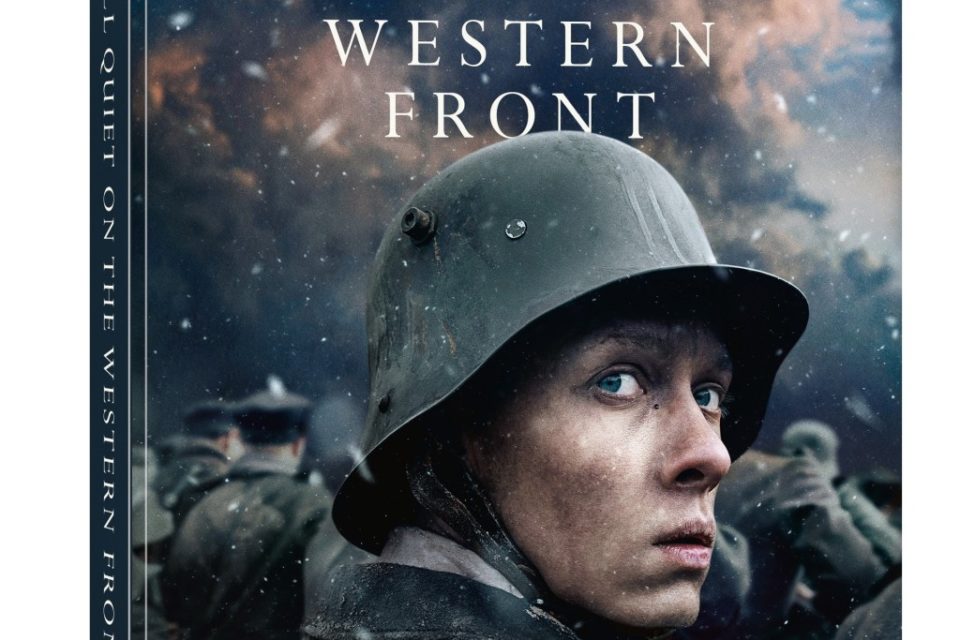The German production of the anti-war/brutal reality of World War I film All Quiet on the Western Front recently came as close as any remake in history to winning an Oscar for Best Picture after the original won the top Academy Award (an American production in 1930). It was the first German film nominated for Best Picture overall and did win Best International Picture and three of its other seven Oscar nominations, as well as winning seven BAFTA awards, among others.
While very few at-home experiences can match seeing a movie in a theater, watching the 2 1/2-hour film in 4K Ultra HD on UHD Blu-ray (Netflix/capelight pictures; $44.98 for 2-disc Limited Collector’s Edition mediabook; Tuesday, March 28) not only exquisitely showcases the vivid visual cinematography of the film but also provides many options and bonuses to enhance the experience. First and foremost, you have your choice of listening to the original German language voices and reading subtitles, or listening to the voices dubbed in English or whatever language you prefer (you’ll for sure need the subtitles for the German post-script wording and credits).
Berger, also one of the writers and producers, offers even more details and anecdotes in a feature-length audio commentary that he says is his first. It might have been helpful for someone else to have joined Berger on the commentary as he gets easily distracted and off-track in the middle of an anecdote while clearly worrying that something else is happening on the screen that he also wants to describe. He winds up stammering and repeating multiple times. Nonetheless, his comments are informative and almost always interesting. We learn that he first read the novel by Erich Maria Remarque when he was 15. It’s a best-seller every year in Germany, he says. Every new generation reads it. His 17 year-old daughter told him he absolutely had to make the movie if he got the chance. “I felt it was the responsibility of our history – the shame and the guilt that comes with it. It was almost a calling. It’s almost in our DNA. We felt it was necessary for the first time to tell this in German by German filmmakers.”
He says he added a lot of dialogue that was not in the book but which he took from history books.
Among his fascinating verbal notes:
- the tanks and flame-throwers used in the war were first-time French inventions that Germans never saw before.
- much of the war was just soldiers charging in the morning a few hundred yards and then retreating back to their own same trench in the afternoon. They did this every day for years as millions of soldiers died (also one of the on-screen notes in the post-script).
- In lighting the battleground scenes, “I never wanted to see the sun – I always wanted it to look as miserable as possible.”
- The sound of sewing machines in an early scene is actually the sound of machine guns firing.
Also included with the limited edition mediabook is a a 24-page full-color booklet with still photos from the film that includes an eight-page conversation with Berger called “Sharing the German Perspective“ and a 15-page interview with historian and professor Daniel Schönpflug on the historical background of the book called “A Machine of Death Unlike Any Experienced Before.”

Like the two previous productions, this newest cinematic incarnation tells the story through the eyes of eager 17-year-old Paul Bäumer (Felix Kammerer), who gets ramped up along with his school mates to become a solider as the war is nearing the beginning of the end in spring 1917 and Germany needs more and younger recruits to carry on the senseless lost-cause battles. His zealousness to beat the French and march into Paris soon turns to eye-opening reality as he first endures rough and too-brief training – endless marching in mud, wearing a gas mask for hours at a time – and is quickly thrown into horrific battles in trenches that are filling up fast with incessant rain and bodies,. He sees his comrades in arms literally blown apart and is forced to kill the enemy in such close hand-to-hand combat that he sees that “the enemy” soldiers are no different than himself.
It’s a remarkably simple and kind of obvious story but, sadly, something that still needs to be dramatized, and this film does it very well. The original, perhaps due to it being in black-and-white, and not feeling as slick and polished (though quite impressive battle scenes for its time), still has more impact. The original – also initially 2 1/2-hours and now a little over 2-hours in a restored edition – also spent more time with the pre-war training in which we get to know better each of Paul’s comrades and leaders, which makes the scene where one of Paul’s buddies is wounded so badly that he takes his own life, hit harder and with more emotion.
This new film spends more time bouncing back and forth from the battlefield to military and political leaders – a fictional character was also created by Berger to help put in perspective the future impact that this war and political situation would have a few years later with the rise of Hitler and the second World War (which hadn’t happened yet when the book was written and the first film was produced a year later).
— By Scott Hettrick

As someone who saw this excellent movie, I appreciated reading your article. Well done, informative.